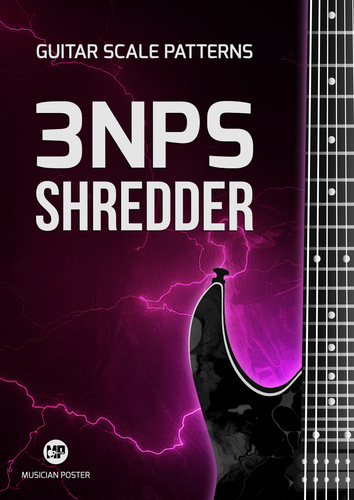Do you feel like there's no end to the number of guitar scale patterns and every other one you find seems to be different and unrelated, even though they have similar titles?
In this reference chart we're focusing on the concept of learning something new by comparing it with a similar alternative you already know. In our case, we are comparing Harmonic Minor with the Natural Minor scale, side-by-side, note-by-note, highlighting the changes. You'll see how a "new" pattern is derived from an existing pattern, and from that point onwards you'll not think of the new pattern as "unrelated" anymore.
The biggest advantage of this approach is that you don't have to memorize a whole new scale pattern. Instead, you only need to learn the changes. Plus, we're using a 3NPS system which is consistent and predictable by design. What that means for you is that even with these changes all patterns still remain strictly 3-notes-per-string.
Our ultimate goal is for you to think in terms of "this new scale is like this other one I know except for one small change". Once you make this connection, you'll have nailed the concept!
Chart features
Minimalistic. This reference has a minimalistic design with no extra guidance and with scale notes shown as empty shapes providing a clean, uncluttered look. It's perfect for seasoned guitar players or simply those who want extra focus.
Side-by-side. 2 patterns that are being compared are placed visually side-by-side, so you can easily hop back and forth between the two to see the changes.
Relevant highlighting only. To help you stay focused on the relevant changes, I've deliberately avoided highlighting anything that could be distracting, such as the roots. The roots are still indicated by square shapes, but they are not color-coded differently to avoid drawing too much attention to them.
7 patterns. The changes are shown for each of the available seven 3NPS patterns, so you had the complete set to analyze and experiment with.
Movable patterns. You can shift any pattern so that its root note aligns with the root note of your choice.
Characteristic note. In this chart we compare Harmonic Minor with the Natural Minor scale. The interesting fact about this is that the resulting difference not only shows you the change you need to make to get the Harmonic Minor scale, but also these same changed tones happen to be the characteristic tones of Harmonic Minor. So you learn 2 things at once: a new scale pattern and its characteristic tone.
Tips and insights
Different scale families. Harmonic Minor is the 1st mode in its own family while Natural Minor is the 6th mode of the Major scale.
This means a lot of things but one of them is that one and the same guitar pattern cannot be used to play both of these two scales, no matter what note you start it from—they will always be different by at least one note and that's what puts them into different families by definition.
By contrast, that's not the case for scales that belong to one scale family, all of which are relative modes of one another. To give you an example, consider Dorian and the Natural Minor scale which are 2 modes of the Major scale—if you know any Dorian guitar pattern or any Minor scale pattern, you can use just that single pattern to play both of these 2 scales just by changing the note you start playing it from. That's a useful feature of relative modes. Make no mistake though, that doesn't make them any "better" ;).
The point is, these 2 scales do have an unavoidable difference (which is also, neither good nor bad, it just is), and you'll need to learn the new pattern in any case, even if the change is only one note. In this case though, this one note also introduces a leap of 2 half-steps, which means that at some point when you'll be playing one of the provided guitar patterns you'll have to skip not 0, not 1, but 2 frets to land on the next note, and this will feel different in your fretting hand than what you're used to if you have never played such scales before. Nothing to be scared of as well, it's just a matter of getting used to ;). Besides, it can additionally serve as an exercise to stretch your fingers.
I'll omit any further details because this is not the focus of this particular reference chart, but I just wanted to mention it here as well. The reason I give such additional bits of information where I feel it's relevant is with the intention that it helps complete the puzzle you might be "solving" in your mind, create an "aha" moment, and if it did, then that's all that matters. And even if not, then you'll start asking the right questions and eventually get the whole picture :)
Alternative scale names
Harmonic Minor is a common and popular name for the scale, but you may also find it under an alias called:
- Aeolian #7















0 Comments